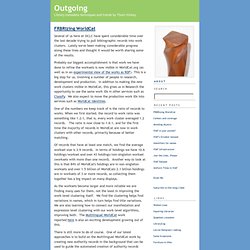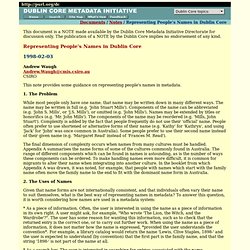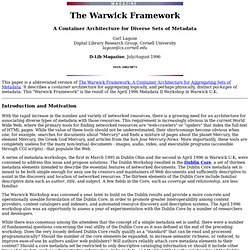

Mapping between metadata formats. MARC 21 to Dublin Core: MARC to Dublin Core Crosswalk - Library of Congress, Network Development and MARC Standards Office, February 2001.Available from: <URL: Dublin Core to USMARC: Dublin Core/MARC/GILS Crosswalk - Library of Congress, Network Development and MARC Standards Office, November 1999.Available from: <URL: See also: MARBI Discussion Paper No. 99: Metadata, Dublin Core, and USMARC: a review of current efforts, January 21, 1997.Available from: <URL: And: MARBI Discussion Paper No. 86: Mapping the Dublin Core Metadata Elements to USMARC, May 5, 1995.Available from: <URL:

ACOC: Overview. Planet Cataloging. Outgoing. We have had an on-again off-again interest here in trying to characterize databases.

Ralph LeVan once had a project called Automatic Collection Description based on centroids found when indexing databases. A few years ago I did some work looking at which OCLC members had the most holdings for headings in WorldCat (and conversely what each OCLC member library had the strongest collections in by heading). For want of a better term I called this work Centers, as in Centers of Excellence. It looked interesting, but we never pursued it very far. Recently, however, we have been doing a lot of work organizing WorldCat. WorldCat is much larger (approaching 300 million records with 2 billion holdings), but new hardware and software (i.e. But even more critically, we now have staff that has been able to take rather raw data, see possibilities in it and relate it to other work (see Constance Malpas's blog post on Concentration, Diffusion, Centers & Flows) and make suggestions. --Th. RDF - Semantic Web Standards. Overview RDF is a standard model for data interchange on the Web.

RDF has features that facilitate data merging even if the underlying schemas differ, and it specifically supports the evolution of schemas over time without requiring all the data consumers to be changed. RDF extends the linking structure of the Web to use URIs to name the relationship between things as well as the two ends of the link (this is usually referred to as a “triple”). Using this simple model, it allows structured and semi-structured data to be mixed, exposed, and shared across different applications. This linking structure forms a directed, labeled graph, where the edges represent the named link between two resources, represented by the graph nodes. Recommended Reading. Dewey Decimal System - A Guide to Call Numbers. Publications and tools. The National Archives has a range of publications to help you manage your records.

For records authorities issued by the Archives other than the Administrative Functions Disposal Authority (AFDA) and AFDA Express (below), please go to Agency-specific records authorities or General records authorities. A checklist for records management and the cloud The use of cloud computing has many potential benefits for Australian government agencies.
A decision to use a cloud service should be based on an assessment of the risks. For records management, this approach will be based on knowing where records will be stored, the value and nature of the records that will be created and stored, understanding the risks that may arise and whether those risks can be satisfactorily mitigated. Appendix A Schemas and Application Profiles. Metadata Object Description Schema: MODS. Library of Congress Authorities (Search for Name, Subject, Title and Name/Title) Word visualiser - Examine word relationships with our word visualizer. Word visualiser Word visualiser help What is the word visualiser?

The word visualiser is an amazing (and beautiful) tool, which lets you explore the meanings of words and the relationships between them. It can be used as a thesaurus of related and alternative words. The visualiser creates a network of 'synsets' from the search term entered. How do I search for a term in the word visualiser? Type your search term into the search box and click the arrow or press return. You can right-click on the screen and drag to move around the page, and use the mouse wheel to zoom in and out. Library of Congress Authorities.
Cathro. Waugh - Representing People's Names in Dublin Core. This document is a NOTE made available by the Dublin Core Metadata Initiative Directorate for discussion only.

The publication of a NOTE by the Dublin Core implies no endorsement of any kind. Representing People's Names in Dublin Core Andrew WaughAndrew.Waugh@cmis.csiro.auCSIRO This note provides some guidance on representing people's names in metadata. 1. While most people only have one name, that name may be written down in many different ways. The final dimension of complexity occurs when names from many cultures must be handled. 2. Given that name forms are not internationally consistent, and that individuals often vary their name to suit themselves, what is the best way of representing names in metadata? Library of Congress Core Metadata Elements. The Warwick Framework. A Container Architecture for Diverse Sets of Metadata Carl Lagoze Digital Library Research Group, Cornell University lagoze@cs.cornell.edu D-Lib Magazine, July/August 1996 This paper is a abbreviated version of The Warwick Framework: A Container Architecture for Aggregating Sets of Metadata.

It describes a container architecture for aggregating logically, and perhaps physically, distinct packages of metadata. This "Warwick Framework" is the result of the April 1996 Metadata II Workshop in Warwick U.K. Introduction and Motivation With the rapid increase in the number and variety of networked resources, there is a growing need for an architecture for associating diverse types of metadata with those resources. A series of metadata workshops, the first in March 1995 in Dublin Ohio and the second in April 1996 in Warwick U.K, were convened to address this issue and propose solutions. Mapping between metadata formats.